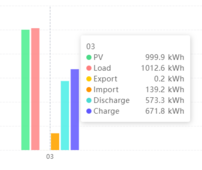No, the AIO inverters with HV DC bus have more conversions than you think.I don't think that is right.
Let's analyze PV directly to grid:
A string inverter going from PV input to AC output is way better than 87-92% efficient. EG4 18KPV (just as an example) is 97.5%. That is a DC coupled system. This makes sense because whatever circuitry you can put into a microinverter you can scale up and put into a string inverter ad would have similar performance. The awful 87-92% number is just wrong for PV to AC for a string inverter.
As for AC couple, that implies microinverters on the panels. Microinverters do achieve about 97% efficient (Enphase IQ7 number for reference) which is similar to a string inverter. If, as is usual, the inverter power is less than the panel power, clipping, you do lose that energy as well.
Net result is that PV to grid, microinverters do not do better than a string inverter, at best, they are about the same, and with clipping, they can be worse.
Now let's analyze going through battery storage.
For the string inverter, the PV input comes in as DC and charges the DC battery. There is a voltage conversion, but it is DC to DC directly and can be quite efficient, 18KPV is 95% doing that. Then to brig the power out of the battery, the string inverter goes DC to AC just once. The 18KPV is 94% efficient doing that. So the round trip efficiency PV to battery to grid is 89%.
For the microinverter system, the PV panels make AC first, then the AC gets converted back to DC to charge the batteries and then makes AC again to power the output. Enphase IQ Battery 10 lists a round trip efficiency of 89% (only at half load, so maybe cheating a bit?). Total including the microinverter loss (but discounting any clipping) is 86%.
Net result is that the string inverter wins on delivering energy through a battery since it has only one DC to AC conversion.
Overall, string inverters are as good on PV to grid, and they win on PV to battery to grid versus microinverters.
Mike C.
For PV directly to AC: PV goes DC to DC from PV to HV DC bus, then DC to AC. Still comparable to a "string inverter" type grid tie or micros.
For PV to batteries: you have DC to DC PV to HV DC bus, then DC to DC HV bus to battery.... which is lower efficiency than a straight up charge controller.
For battery to AC: you hav DC to DC from battery to HV DC bus, then DC to AC from HV DC bus to AC.
As long as probably 50% or more goes directly from PV to AC, you are further ahead that way. Once you are under 50% direct to AC, you are way more efficient using charge controller and "low frequency" grid sell capable inverter such as Schneider XW or even Midnite Rosie (I know, that one is technically "high frequency.")
By the way on an AC coupled system, you have an inverter like the Schneider XW, or something similar, with either a "string inverter" type grid tie inverter, or micros, on the critical loads side "AC coupling" to the output of the battery inverter, or grid when the battery inverter is connected to grid.
An 18kPv is not just a string inverter! It is a hybrid string inverter with battery option. Normally what is referred to as a "string inverter" is simply an grid tie inverter that gets a "string" of solar panels connected to it, whereas a micro inverter only gets connected to anywhere from 1 to 4 solar panels. With a string inverter you have 1 (or sometimes a few, on bigger systems) inverter that handles all the solar panels. A micro inverter will have 1 (or sometime more, up to 4) solar panels plugged directly into it.... benefits are less issues with partial shading. Drawbacks far outweigh benefits.... but that's a whole other can of worms. More components to go bad, more electrical connections to go bad, more heat for mocros because of being mounted on or under the panels, etc....
Anyway... at the end of the day, when using batteries (actually cycling them, that is.....) AC coupled or HV AIO inverters are usually both not as good an option as good old charge controller and inverter....



